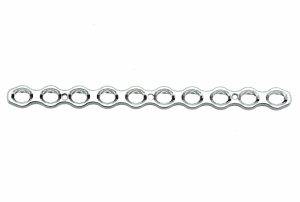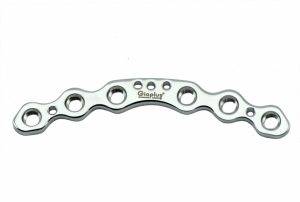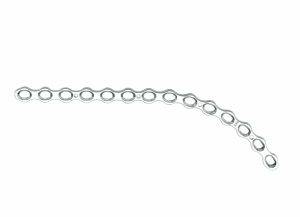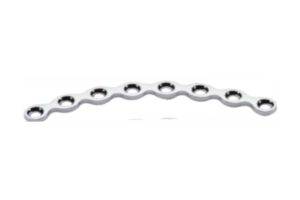ORTHOPEDIC IMPLANTS
Pelvis Plating
We are a leading medical implant manufacturer in India offering best in class pelvic plating systems consisting of a full collection of plates, screws and instrumentation.

Frequently Asked Questions
A pelvic plating system is a type of medical implant used to treat fractures and other injuries of the pelvic bones. Our pelvic plating systems consisting of a full collection of plates and screws made of surgical grade stainless steel or titanium as well as complete instrumentation.
Our medical implant sets are ideal for temporarily fixating, rectifying, or stabilising the pelvic bones and it provides much needed stability and support to the affected bones of the pelvic region. Our pelvic plating system is purpose built for osteotomies, fusions, and fractures of the ilium, sacrum, acetabulum, and pelvic ring. Dislocation of the pubic symphysis and sacroiliac joint can also be treated with our Pelvic Plating System.
The medical implants in our pelvic plating system are partially contoured at certain locations to save the time of orthopedic surgeons, while certain areas are deliberately left uncontoured where the orthopedic implant may require personalised contouring based on the patient’s skeletal contours.
A pelvic plating system is indicated to be used for the treatment in cases of more severe injuries or conditions affecting the bones of the pelvis and is chosen on a case-by-case basis by a qualified healthcare professional. Common indications for the use of a pelvic plating system:
Dislocations of the hip joint: A dislocated hip joint can occur as a result of trauma or a congenital abnormality. A pelvic plating system may be used to stabilise the pelvic bones and restore the normal position of the hip joint.
- Unstable pelvic ring: The pelvic ring is made up of several bones that are interconnected. If one or more of these bones is fractured or otherwise injured, the entire pelvic ring may become unstable. A pelvic plating system can be used to stabilise the pelvic ring and allow for proper healing.
- Symphyseal separation: The pubic symphysis is the joint between the two pelvic bones at the front of the pelvis. In some cases, this joint may become separated due to trauma or pregnancy. A pelvic plating system may be used to stabilise the joint and allow for proper healing.
- Malunion or nonunion of a pelvic fracture: In some cases, a pelvic fracture may not heal properly, leading to malunion or nonunion. A pelvic plating system can be used to provide stability and support to the affected bones and promote healing.
- Fractures, fusions, and osteotomies of the acetabulum: The acetabulum is the socket of the hip joint, and injuries to this area can result in severe pain and instability. A pelvic plating system can be used to stabilize the acetabulum after a fracture or during a surgical procedure such as a hip replacement.
- Fractures, fusions, and osteotomies of the sacrum: The sacrum is a large, triangular bone located at the base of the spine. Injuries to the sacrum can cause pain, instability, and difficulty walking. A pelvic plating system can be used to stabilise the sacrum after a fracture or during a surgical procedure such as a spinal fusion.
- Fractures, fusions, and osteotomies of the ilium: The ilium is one of the three bones that make up the pelvic ring. Injuries to the ilium can cause pain, instability, and difficulty walking. A pelvic plating system can be used to stabilise the ilium after a fracture or during a surgical procedure such as a pelvic fusion.
- Fractures, fusions, and osteotomies of the pelvic ring: The pelvic ring is made up of the ilium, pubis, and ischium bones, and injuries to this area can be serious and potentially life-threatening. A pelvic plating system can be used to stabilise the pelvic ring after a fracture or during a surgical procedure such as a pelvic fusion.
- Sacroiliac joint dislocations: The sacroiliac joint is located where the sacrum and ilium bones meet, and injuries to this joint can cause significant pain and instability. A pelvic plating system can be used to stabilise the sacroiliac joint after a dislocation.
- Pubic symphysis disruptions: The pubic symphysis is the joint between the two pubic bones at the front of the pelvis. Injuries to this joint can cause significant pain and instability. A pelvic plating system can be used to stabilise the pubic symphysis after a disruption.
GiaPlus is a leading orthopedic implant manufacturer in Mohali that specialises in the design and manufacturing of orthopedic implants, including a wide range of pelvic plates. Our product portfolio includes various types of plates that are designed to address different types of pelvic injuries and conditions. Some of the common types of pelvic plates offered by GiaPlus include:
- Pelvic Spring Plate: The Pelvic Spring Plate is a versatile implant that is designed to provide stabilisation for the anterior pelvic ring. It is typically used for the treatment of pubic symphysis disruptions, sacroiliac joint dislocations, and fractures of the pubic rami.
- Pelvic Reconstruction Straight Plate: The Pelvic Reconstruction Straight Plate is a long plate that is designed to provide stabilisation for the posterior pelvic ring. It is typically used for the treatment of sacral fractures, iliac wing fractures, and acetabular fractures.
- Pelvic Symphysis Plate: The Pelvic Symphysis Plate is a small plate that is designed to provide stabilisation for the pubic symphysis. It is typically used for the treatment of pubic symphysis disruptions.
- Pelvic J Plate Left & Right: The Pelvic J Plate is a contoured plate that is designed to provide stabilisation for the ilium and sacrum. It is typically used for the treatment of sacroiliac joint dislocations and fractures of the sacrum and ilium.
- Pelvic Reconstruction Plate: The Pelvic Reconstruction Plate is a versatile implant that is designed to provide stabilisation for the posterior pelvic ring. It is typically used for the treatment of sacral fractures, iliac wing fractures, and acetabular fractures.
- Anatomical Pelvic Plate LCP: The Anatomical Pelvic Plate LCP is a contoured plate that is designed to provide stabilisation for the posterior pelvic ring. It is typically used for the treatment of sacral fractures, iliac wing fractures, and acetabular fractures. The plate is anatomically contoured to match the shape of the pelvic bone, which can help to reduce the risk of implant failure and improve patient outcomes.







